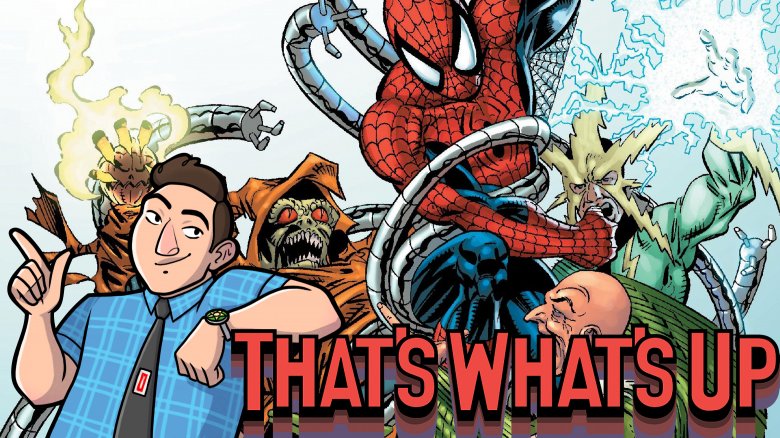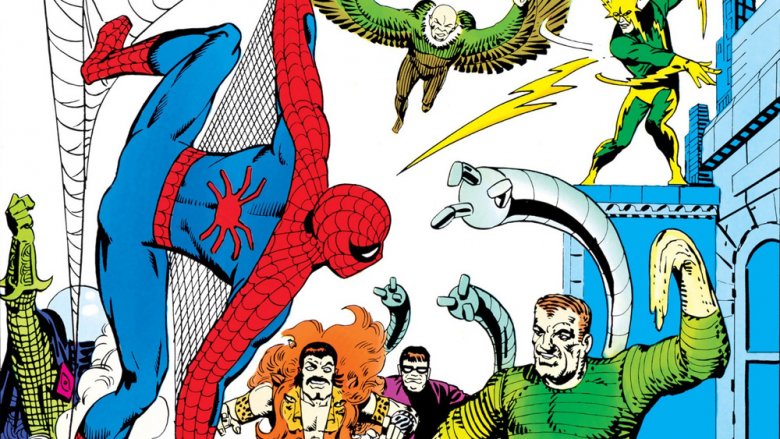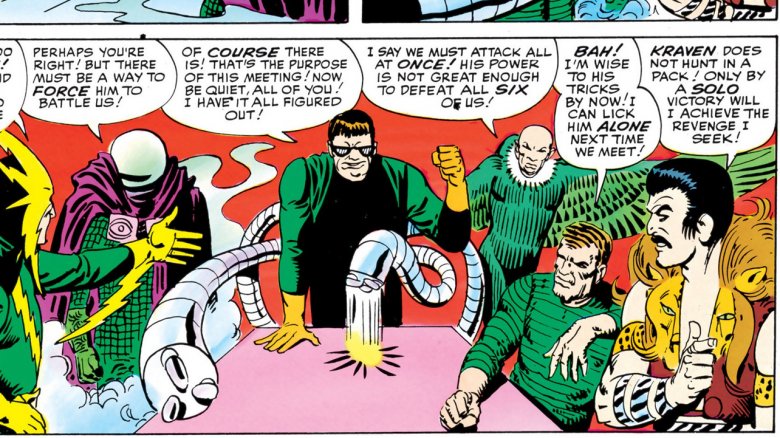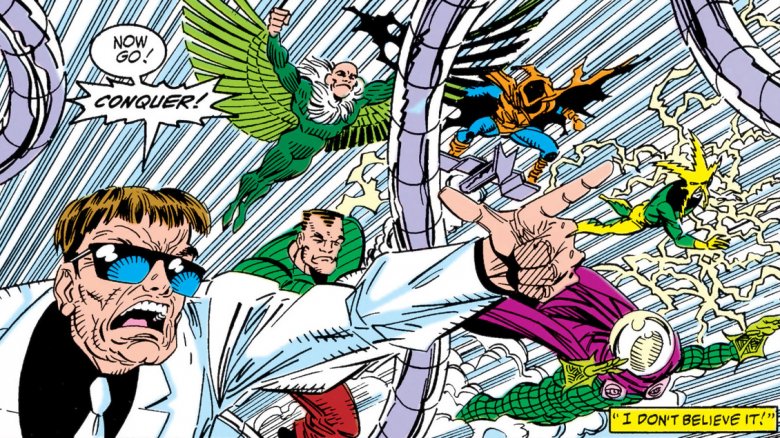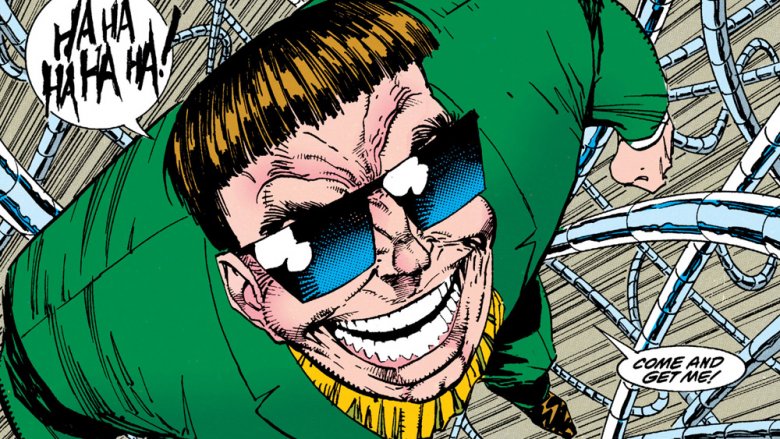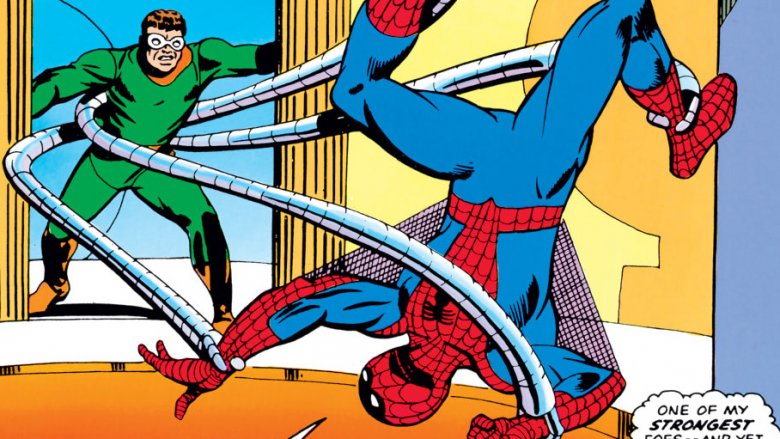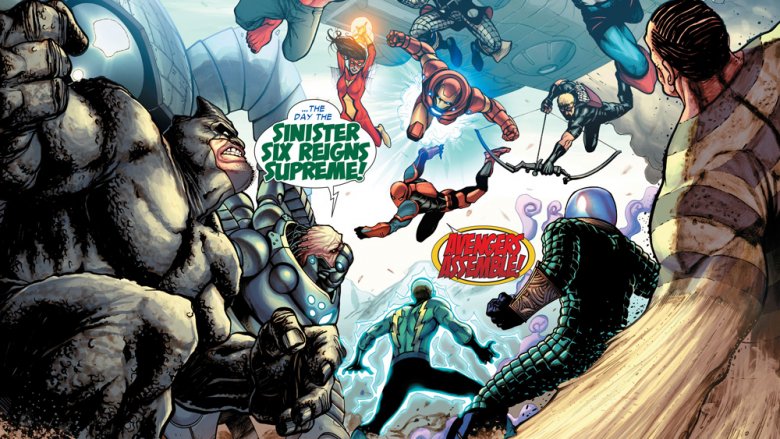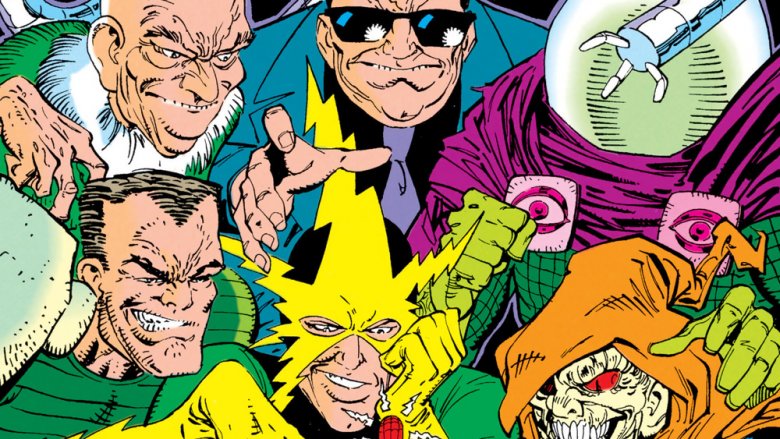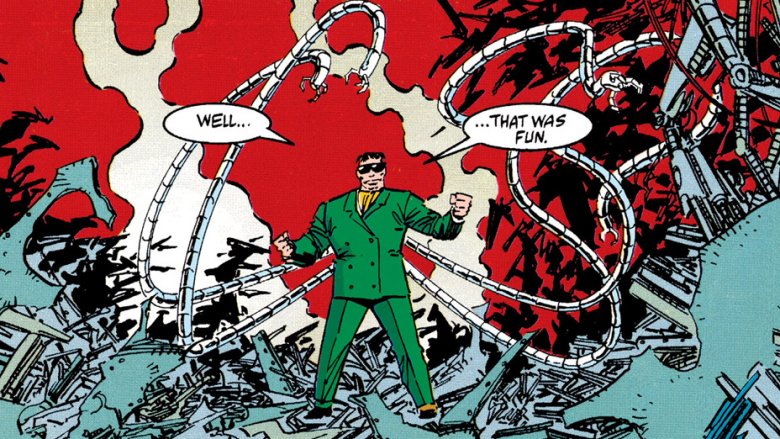That's What's Up: What's The Deal With The Sinister Six?
Each week, comic book writer Chris Sims answers the burning questions you have about the world of comics and pop culture: what's up with that? If you'd like to ask Chris a question, please send it to @theisb on Twitter with the hashtag #WhatsUpChris, or email it to staff@looper.com with the subject line "That's What's Up."
Q: What's up with the Sinister Six? Are they a cohesive team, or just a bunch of random villains who got a cool name? — via email
Like a lot of people, I've spent the past few months thinking a lot about the Sinister Six, mostly because the PlayStation 4 Spider-Man game started out with Peter Parker taking on Mister Negative and then pulled a hard swerve into being an origin story for a full-on supervillain team-up. It's a great way to ramp things up in the video game, but one of the many reasons that it works so well is that it mirrors how the team works in the comics. They are, in fact, a pretty random assembly of villains who gave themselves a cool name back in 1964, but they also do function as a cohesive unit that has a claim on being the best evil team in comics history, because they're an extension of one man's twisted, indomitable will.
And also because they're a bunch of dudes who just really, really hate Spider-Man.
And then there were six!
Before we get into the fiction, it's worth noting that the Sinister Six as a concept were actually a pretty revolutionary concept for superhero comics. When they first appeared in the first-ever Amazing Spider Man Annual, they were a pretty simple means to the end that was promised in the blurb on the cover: delivering "Spidey's biggest, longest, greatest battle!" That, by the way, is something I've always found hilarious. Stan Lee and Steve Ditko aren't promising the "best" Spider-Man battle, just the longest one. The fact that it actually did turn out to be one of the best of the decade, if not of all time, was almost an afterthought.
In retrospect, it seems like the most obvious way to ramp things up: taking all of these villains who were threats in their own right and teaming them up to increase the danger. As far as I can tell, though, in 1964, that wasn't really a thing. There had been villainous team-ups here and there for a while, but those were always limited to two villains, usually taking on two heroes, like the Joker/Lex Luthor team-up stories of the '50s. The only example I can think of where established, individual villains formed a supergroup happened two decades before, in the infamous "Monster Society of Evil" story in Captain Marvel Adventures, and that would've been all but completely forgotten by the younger readers at the dawn of the Marvel Age of Comics.
It would eventually become a pretty standard tactic, of course. The Frightful Four would make their first appearance as the Fantastic Four's opposite numbers in '65, and in 1966, the Batman movie would feature four arch-criminals brought together as the United Underworld. In this comic, though, readers were given something that they likely hadn't seen before, something that would change how supervillains worked forever — especially in Spider-Man comics.
The working man's villain team
One of my favorite things in comics — in any media, actually — is the idea of the occupational supervillain. You know, the people that aren't necessarily evil in the "I want to launch puppies out of catapults into the sun" sense, but instead find themselves on the wrong side of the heroes because doing crimes is steady work, and in this economy, we can't be too picky about it. Characters like Destro in G.I. Joe, who is less of a devotee to Cobra's plot for world domination and more of a guy who likes building things like Trouble Bubbles and Weather Dominators that, for some reason, the U.S. Military decided to pass on. As much as I love characters like the Joker or Doctor Doom or Darkseid, who have these much loftier, more intense desires at the core of their characters, I'll always have a soft spot for the ones for whom evil is just a job.
A lot of Spider-Man villains fall into this category, and it makes sense that they would. Spidey is, after all, the character who defined the idea of the working-class superhero. While that idea obviously lends itself to going up against the rich and powerful, like Norman Osborn and the Kingpin — he was Spidey's guy first, back before Frank Miller decided that he was a better opposite number for a clinically depressed lawyer — it makes sense that at least a few of his villains would fall into the same category. Villains like the Shocker, Electro, even the Sandman — these aren't world-beaters, they're guys who found themselves inextricably linked to the fundamental forces of the universe, and decided that they should use those unfathomable powers to get ahead on rent for a change. Unsurprisingly, that makes them pretty easy to identify with.
And that, more than anything else, is what led to the formation of the Siniser Six. With a few notable exceptions, they're not villains who are driven by all-consuming hatred for Spider-Man. They're just a bunch of dudes who really don't like that guy.
The ninth arm of Doctor Octopus
The exception, of course, is their leader. While there are a few incarnations over the years that haven't included him — including the "All-New Sinister Six" led by Swarm, who is literally a Nazi made of bees — the Sinister Six has always been a pet project for Dr. Otto Octavius, better known as Doctor Octopus.
That's something else that dovetails with the idea of Spider-Man's blue-collar villains. Since they all default to being pretty self-interested and straightforward, they need someone else in the leadership role, either bankrolling the operation or just directing the others in service of a master plan. That's where Doc Ock comes in. He's the mastermind, the person who has the resources that makes it worth it for someone like the Shocker or the Vulture to join in.
In fact, Amazing Spider-Man Annual #1 represents a huge change for Doc Ock. While he was an interesting villain back in his first appearance, the idea that he's the one behind a plot that encompasses all of Spidey's major foes (circa 1964) is the first step in becoming Spider-Man's greatest villain. Yeah, you heard me: Doc Ock is Spidey's greatest foe, and I don't care who he threw off a bridge, Norman Osborn can pound sand.
The deadliest foe of Spider-Man
If you'll forgive me for going off on a tangent for a moment, I really do think it's important to establish Otto Octavius as the Spider-Man villain, because that in turn is the element that truly makes the Sinister Six work.
That might seem like a controversial statement. For a lot of readers, and especially for the people who primarily know Spider-Man from movies, it probably seems like that's a title that should go to the Green Goblin, and for a particular sort of '90s Kid, it's just as obvious that it should be Venom. But in the comics, there's no question. Pound for pound, story for story, there's no single Spider-Foe who has been at the center of more compelling plots than Doc Ock. He's the bridge between those different kinds of villains, the world-beater who can believably threaten an entire planet with destruction, who can also mingle with the lower tier of bad guys, with the genius to match Peter Parker (and, on one occasion, Reed Richards) and confront him on that level, too. He even has powers that give him the same sort of range of motion that's so important for Spider-Man's battles through a cityscape.
We all remember Spider-Man struggling against all odds to lift that heavy pile of rubble in Amazing Spider-Man #33, a moment that has defined the character to the point of being recreated in live-action at the climax of Spider-Man: Homecoming. It's worth noting, however, that Doc Ock is the guy who put Spidey underneath that rubble. And he's the one who literally took over Spider-Man's body and life as the Superior Spider-Man. Also, he's the one who tried to take over the world through cocaine addiction, but we'll get back to that in a second.
Six against One
As for how that shift happens, from Doc's introduction as just another in a long, long line of animal-themed Spider-Man villains to his absolute arch-nemesis, it begins with the formation of the Sinister Six. It almost happens by default, too, because none of the others (with the possible exception of Kraven the Hunter) would work as the leader of a team, but the important part is that it happens. And it's great.
If you want to go back and read one Spider-Man comic from the Stan Lee/Steve Ditko era, then... well, you should probably read Amazing #33, since that's literally the best single superhero comic ever published. After that, though, this annual is the one to get. It's got a fast-paced thrill ride of a story with Spidey taking on each member of the Six one right after the other, with Ditko giving each villain a lavish splash page at the height of the action. The one with Kraven alone, where Spidey's fighting off two leopards and a supervillain at the same time, almost makes the issue all on its own.
And that's the issue that sets the tone, not just for Spider-Man, not just for Doc Ock, but for everything. The next time we see Doctor Octopus, it's in the guise of the Master Planner, furthering his transition from solo superhero to full-on archvillain for that climactic battle in "If This Be My Destiny." It also reinforces the idea of Spider-Man, a character who was already a hit, as someone who's constantly fighting from a disadvantage despite his considerable powers. He's always going to be outnumbered. He's always going to be pushed to his limits. He's always going to have one more villain to fight.
Return, Revenge, Reinforcements
With all of that established right up front, the Sinister Six become one of the greatest recurring forces in comics, and what really makes them great is that teaming up doesn't stop them from working well on their own. Being unable to defeat Spider-Man as part of a team didn't stop Kraven the Hunter from being a compelling threat in Kraven's Last Hunt, for instance. In fact, I'd say that having a team of their own actually makes those villains even more compelling.
One of the things that solo stories set in a shared superhero universe can never really get around is the idea that when it really comes down to it, the heroes can always call for backup. It's one of the only real problems with a story like Batman's No Man's Land arc from 1999 — if Gotham City is truly devastated by an earthquake, abandoned by the government, and overrun with criminals, then why don't Batman's pals Superman and Wonder Woman show up to help out? Isn't that the entire reason that the Justice League exists, to stop things like the absolute destruction of major population centers? It becomes something that you have to write your way around in order to make things exist in a larger context, and that's not just something that exists in the DC Universe. To keep things in the Spider-Man family, it's why one of the most memorable moments in Maximum Carnage comes when Captain America shows up. That's when you know it's real, because now the whole universe is involved in this problem.
The Sinister Six, as a concept, gives that advantage that's usually reserved for the heroes to the villains. Electro can be a big deal all by himself, but if his actions are linked with a larger, more sprawling plot, then you never know when things are going to suddenly get worse for Spider-Man. The fact that Spider-Man knows this, and that he has to prepare for it being a possibility every time he goes up against one of his classic foes, helps to increase the tension in every story.
Just say no to super-crime
Which brings us back, at last, to 1990's "Return of the Sinister Six," a truly bonkers story that also shows how all of these disparate elements combine to make the Sinister Six work so well. I mean, there's probably a better example in "Ends of the Earth," the more recent story where Doc Ock spends a couple years worth of comics reforming the team in order to extort the entire world under the threat of global annihilation, but since that story has zero cocaine rockets, you'll understand why this is the one that I wanted to talk about.
If you can get beyond the extremely wild premise, you'll see how everything we've talked about already comes together for it. It starts with Doctor Octopus reforming his team, and like the original story, the core motivation comes from a very personal desire for revenge. This time, it's not just for their personal defeats, but their defeats as the Sinister Six — in most cases, at least. Kraven was temporarily dead and was replaced by the Hobgoblin, and the Sandman's alignment had shifted more towards a morally gray area. He wound up having to be blackmailed into it, and then wound up turning on Doc Ock at the end, only to be instantly turned into glass by one of Otto's contingency plans.
Which points to the larger element. Like all of the best Sinister Six stories, this one was built around a plot that consisted of wheels within wheels. The initial setup is that Doc Ock is going to extort the world's powers (kind of his thing) by stealing a rocket and using a space-based poison dispersal system to hold the planet for ransom. That gave the whole thing a sort of video game setup of distinct "levels" and "boss fights" that, by 1990, was already becoming more familiar and reliable to readers. Then comes the twist: Doc Ock is actually trying to take over the world by using a chemical the cures cocaine addiction but also makes all drug use extremely painful, with which he will extort all of high society's most powerful figures, who as we all know are already addicted to that sweet, sweet yayo. Oh, and just in case this wasn't the most early '90s story you can imagine, there's a second twist about how the cocaine cure is actually dissolving the ozone layer.
The Sinister Six reign superior
Whether it's in that story or something else, the structure still holds up, just like it did back in 1964. I mentioned that it shares similarities with what readers would expect from a video game, but that's because it's a classic setup that emphasizes a hero's limitations to make their eventual triumph mean more. It's a gauntlet with a twist or two, a battle that spirals out into something bigger and more complicated every time it happens.
And really, Spider-Man's one of the few heroes who actually has that. Batman's foes, while they're probably the best assembly of villains in the entirety of superhero comics, don't have that easy team-up element to them. At most, they're occasionally manipulated into acting in concert, or set up to challenge Batman in a sequence, like they were in Knightfall, but there's not that identification with each other that you see in the Sinister Six. The Flash's Rogues are the opposite — they have that working man sensibility and a shared sort of villainous fraternity that gives them a depth of character, but it's difficult to believe that Captain Cold or Weather Wizard are going to conquer the world. Spidey exists in that sweet spot, and the Sinister Six plays off of that idea beautifully.
They make Spider-Man more heroic. They make Doctor Octopus more villainous. They make the other villains involved more tragic or, well... sinister. They're that rare element of comics that makes everything better, even on those sad occasions when the stories don't have cocaine rockets.
Each week, comic book writer Chris Sims answers the burning questions you have about the world of comics and pop culture: what's up with that? If you'd like to ask Chris a question, please send it to @theisb on Twitter with the hashtag #WhatsUpChris, or email it to staff@looper.com with the subject line "That's What's Up."
